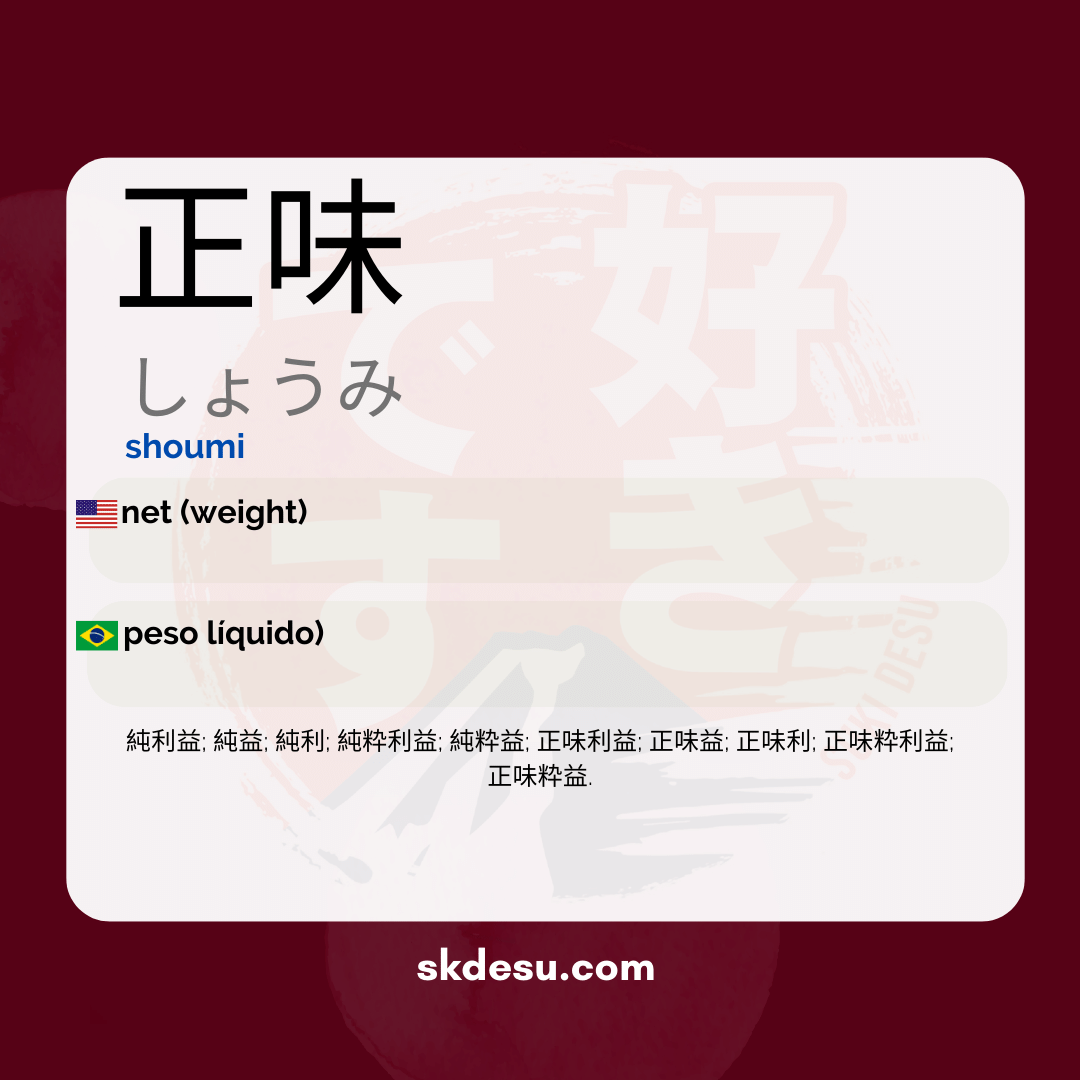Translation and Meaning of: 正味 - shoumi
The Japanese word 正味 [しょうみ] may seem simple at first glance, but it carries interesting nuances both in meaning and in everyday use. If you are studying Japanese or just curious about specific terms, understanding 正味 goes beyond a simple translation. This article explores its meaning, origin, and how it is applied in different contexts, from supermarkets to informal conversations.
In addition to uncovering what 正味 represents, we will discuss its writing in kanji, pronunciation, and practical examples that facilitate memorization. Whether to expand your vocabulary or to avoid confusion with similar words, this guide offers accurate and useful information for students and enthusiasts of the Japanese language.
Meaning and usage of 正味
正味, read as "shōmi", primarily means "net" or "real", especially when referring to quantities. In the context of shopping, for example, it appears on packaging to indicate the net weight of a product, excluding the packaging. This application is common in the daily lives of the Japanese, especially in supermarkets and convenience stores.
Outside of the commercial context, 正味 (shōmi) can also be used to express the essence of something, as in "正味の話" (shōmi no hanashi), which means "to speak the truth" or "to get straight to the point." This flexibility makes the word useful in both formal and informal situations, as long as it is applied correctly.
Origin and writing in kanji
The composition of 正味 in kanji helps to understand its meaning more deeply. The first character, 正, means "correct" or "fair," while 味 can be translated as "taste" or "essence." Together, they form the idea of "real value" or "essential content," which explains its use to indicate liquid measures or unembellished truths.
It is worth noting that 正味 is not an ancient or rare word. It is present in modern Japanese and is widely recognized, although it is not as common as more generic terms. Its origin is not linked to specific historical periods but rather to the natural evolution of the language to express practical concepts of everyday life.
Tips for memorizing and using correctly
An effective way to reinforce 正味 is to associate it with concrete situations, such as reading product labels in Japanese. Practicing with real examples, like "正味重量" (net weight) or "正味時間" (effective time), helps to internalize the term. Another tip is to create flashcards with sentences that contrast gross and net weight, highlighting the use of 正味 in the second case.
It is important not to confuse 正味 with similar words like 実際 (reality) or 純粋 (pure). While 正味 refers to measurable quantities or truths, the other terms carry more abstract connotations. Paying attention to these details prevents misunderstandings when speaking or writing.
Vocabulary
Expand your vocabulary with related words:
Synonyms and similar words
- 純利益 (Jun rieki) - Net profit
- 純益 (Jun eki) - Pure profit
- 純利 (Jun ri) - Pure profit
- 純粋利益 (Junsui rieki) - Genuine profit
- 純粋益 (Junsui eki) - Genuine benefit
- 正味利益 (Shōmi rieki) - Real net profit
- 正味益 (Shōmi eki) - Net real benefit
- 正味利 (Shōmi ri) - Actual profit
Related words
Romaji: shoumi
Kana: しょうみ
Type: noun
L: jlpt-n2
Translation / Meaning: net weight)
Meaning in English: net (weight)
Definition: The important or essential part of something.
Quick Access
- Vocabulary
- Writing
- Sentences
How to Write in Japanese - (正味) shoumi
See below a step-by-step guide on how to write the word by hand in Japanese. (正味) shoumi:
Example Sentences - (正味) shoumi
See below some example sentences:
Nenhum resultado encontrado.
Other Words of this Type: noun
See other words from our dictionary that are also: noun

